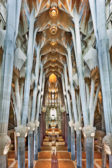Articles by David Cohn
#house#1.130
Down the Garden Path: A house on a tight suburban site provides a series of choreographed views through landscaped spaces and pavilion-like rooms.
Read More
Héctor Fernández Elorza Architects
Rooted in Spain but influenced by Sweden, a Madrid-based architect combines the rugged and the refined.
Read More
Grupo Aranea
A firm rooted in hand-drawing adapts natural forms to create a flowing architecture.
Read More
Relojería Alemana
Midas Touch: On a tony new marina, a young duo crafts a glittering jewel box for a storied luxury retailer.
Read More
Torre Júlia
Social Network: A trio of young architects enlivens a housing block for seniors by cleverly manipulating its facades and creating a series of community spaces.
Read More
Renaissance Barcelona Fira Hotel
Urban Oasis: Ateliers Jean Nouvel creates a lively, playful hotel tower amid the city's dismal fringes.
Read More
El Greco Congress Center
Climbing The Wall: A design team weaves a new convention center into the fabric of an ancient hilltop city virtually unscathed by the ravages of time.
Read More
Atrium House
The Box Stripped Bare: An elegant design near Valencia taps into the same gene pool as Modernist landmarks from the 20th century.
Read More
Copyright ©2024. All Rights Reserved BNP Media.
Design, CMS, Hosting & Web Development :: ePublishing
